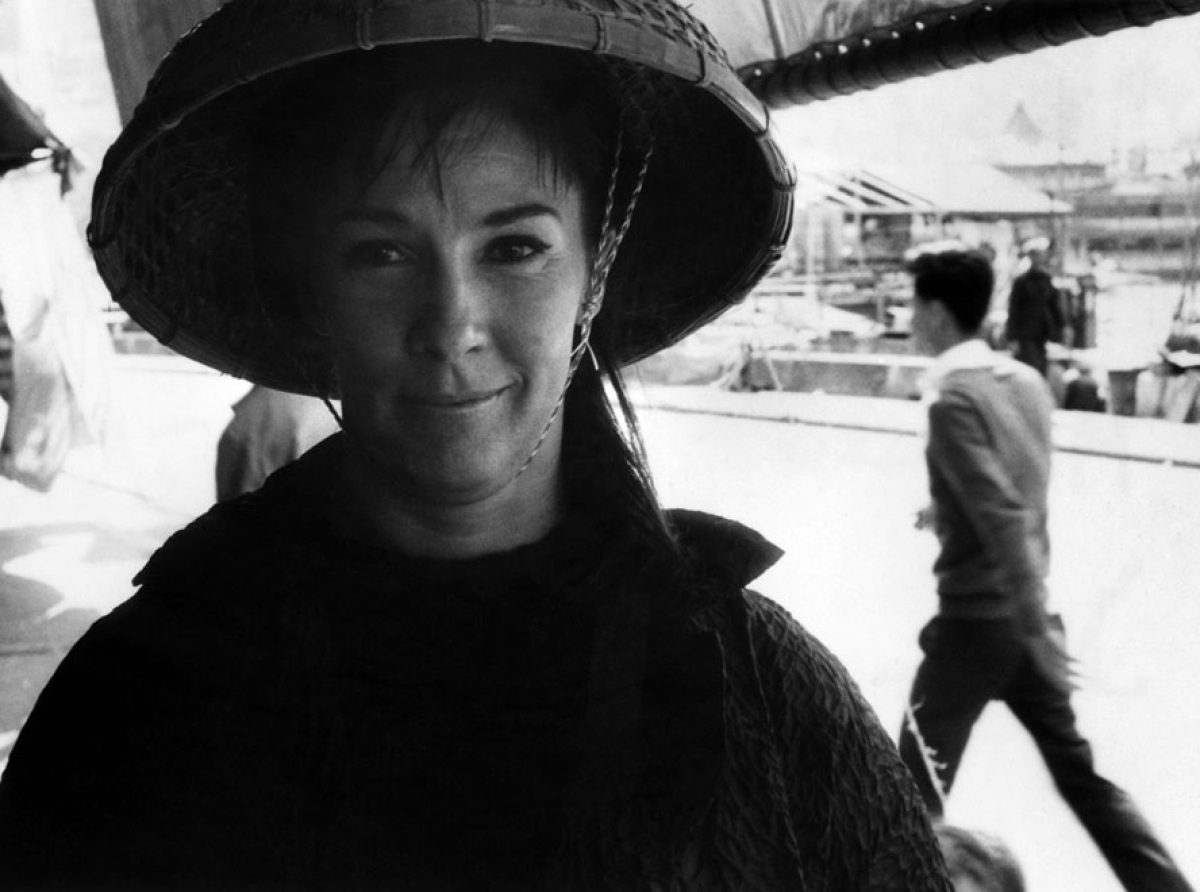Many of us aikidoka are eager to read about the lives of the various pioneers of our art. From the direct pupils of Ueshiba Morihei who first went abroad, to the early Westerners who gave up everything to meet with the founder, there is no shortage of colorful and inspiring stories. Some, however, seem to be conspicuously missing from the record, even though their lives are nothing less than incredible, even worthy of a book in themselves. One of such people is early American aikido practitioner Virginia Mayhew. Though her name is mentioned at times by better known instructors, few resources are actually available about her life. Today I would like to look back into her incredible life and highlight her influence on the development of our art.
Early Life
Virginia Bailey (nicknamed "Ginger") was born on September 21, 1928 in New York City as the third child of Charles Bailey and Ida Mayhew, two music teachers. Life would soon bring its share of challenges though, with her father leaving the family home in the late 1930’s, her brother being institutionalized due to tuberculosis, and her sister Frannie dying of pneumonia in 1938. On top of all that, Virginia got struck by lightning the previous winter, which left her with heart problems.
By 1942, a media campaign had been launched to encourage middle and upper class white women to enter the workforce to make up for the lack of men who were at war. Virginia dropped out of high school at age 14 and started working for a general contractor in Fairhaven, Massachusetts, who ended up using a photo of her while she was painting a house to advertise his business.
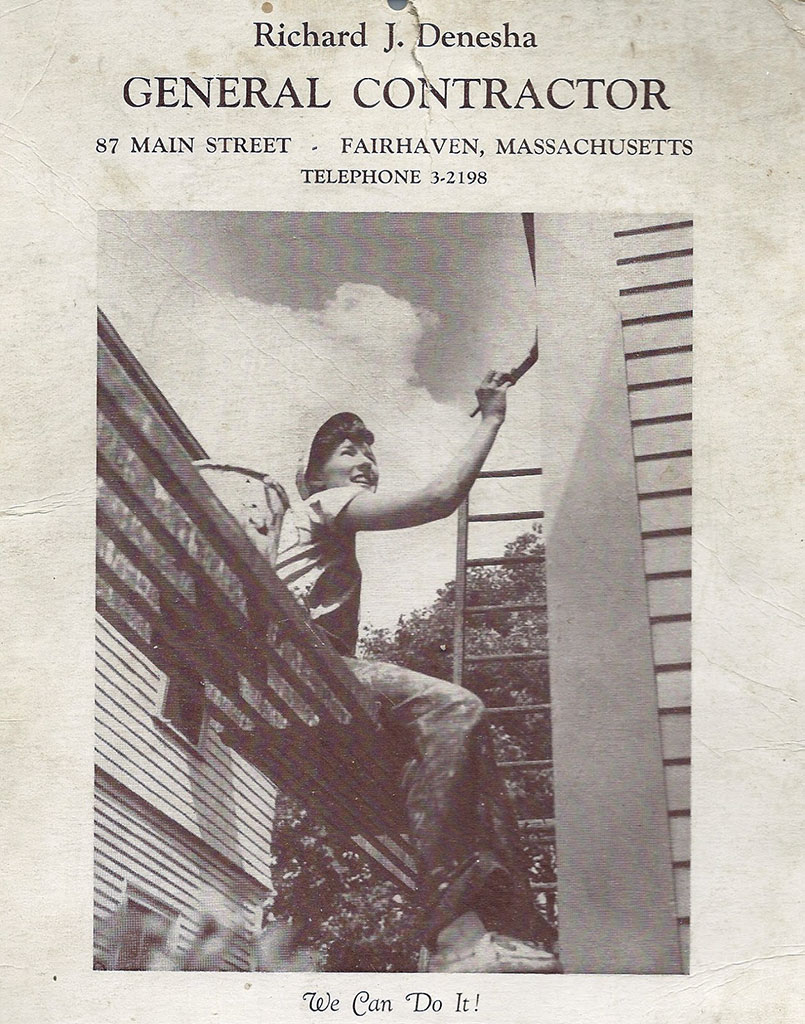 Virginia Mayhew on the ad put together by Richard Denesha to advertise his company (1943).
Virginia Mayhew on the ad put together by Richard Denesha to advertise his company (1943).
As fate would have it, the picture was noticed and Virginia was hired by famous costume designer Gilbert Adrian to become the model for his “Saint and Sinner'' perfume line ad campaign, which ran in Vogue and Town & Country magazines from 1944 to 1946. She continued on her newly found modeling career and became the face for Charbert's “Breathless...Fabulous” perfume line.
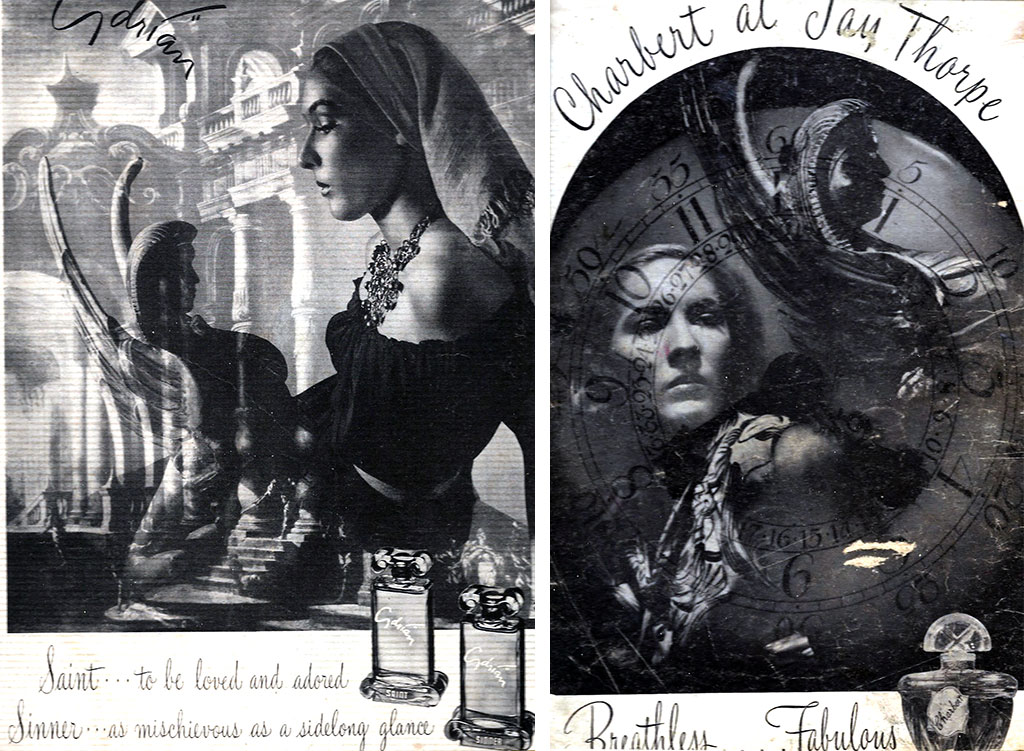 Virginia Mayhew on the ads of the “Saint and Sinner'' and “Breathless... Fabulous” perfume lines.
Virginia Mayhew on the ads of the “Saint and Sinner'' and “Breathless... Fabulous” perfume lines.
Virginia was able to move to New York’s Greenwich Village, where she played the guitar and performed folk songs at various local night clubs. There, at age 17, she met renown archaeologist and early Beat Circle member, Haldon Chase. Chase introduced her to his circle of literary friends, where her extrovert and spontaneous personality made quite an impression. With the end of the war in sight, Ginger's family pressured her to leave her modeling and singing career in order to get married. She and Chase exchanged vows in 1945 after his graduation from Columbia University and the couple moved to his family's home in Denver, Colorado.
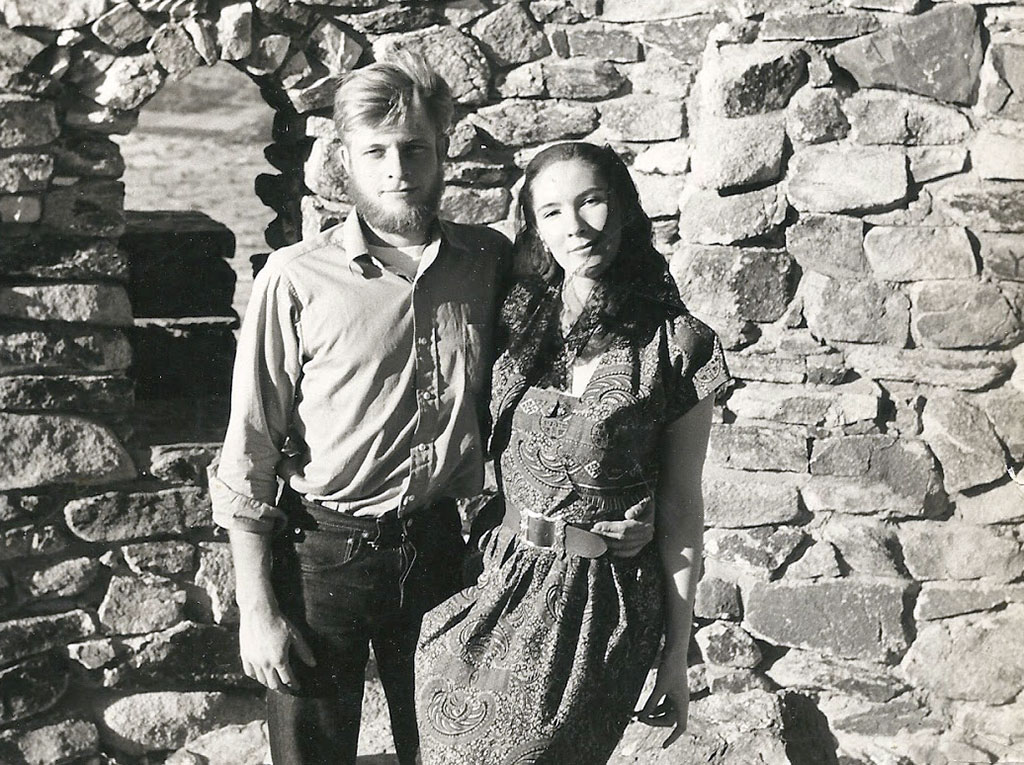 Haldon Chase and Virginia Mayhew at an archaeological field site in southeastern Colorado, 1949
Haldon Chase and Virginia Mayhew at an archaeological field site in southeastern Colorado, 1949
Virginia took an active part in Chase’s field work and she followed him when he went to study the Zapotec language in Mexico. Not the sort of person to stay idle, she spent her time collecting Mexican folk songs, but Chase’s desire to have her focus on house tasks clashed with Virginia’s fierce independence, and the two eventually divorced in 1951.
When she returned to New York she started singing at the Village Vanguard, but needing a fresh start, she changed her professional name from Ginger Bailey to Ginny Mayhew around 1953 and spent about two years in the Caribbean performing songs at nightclubs in Haiti, Santo Domingo, and the U.S Virgin Islands.
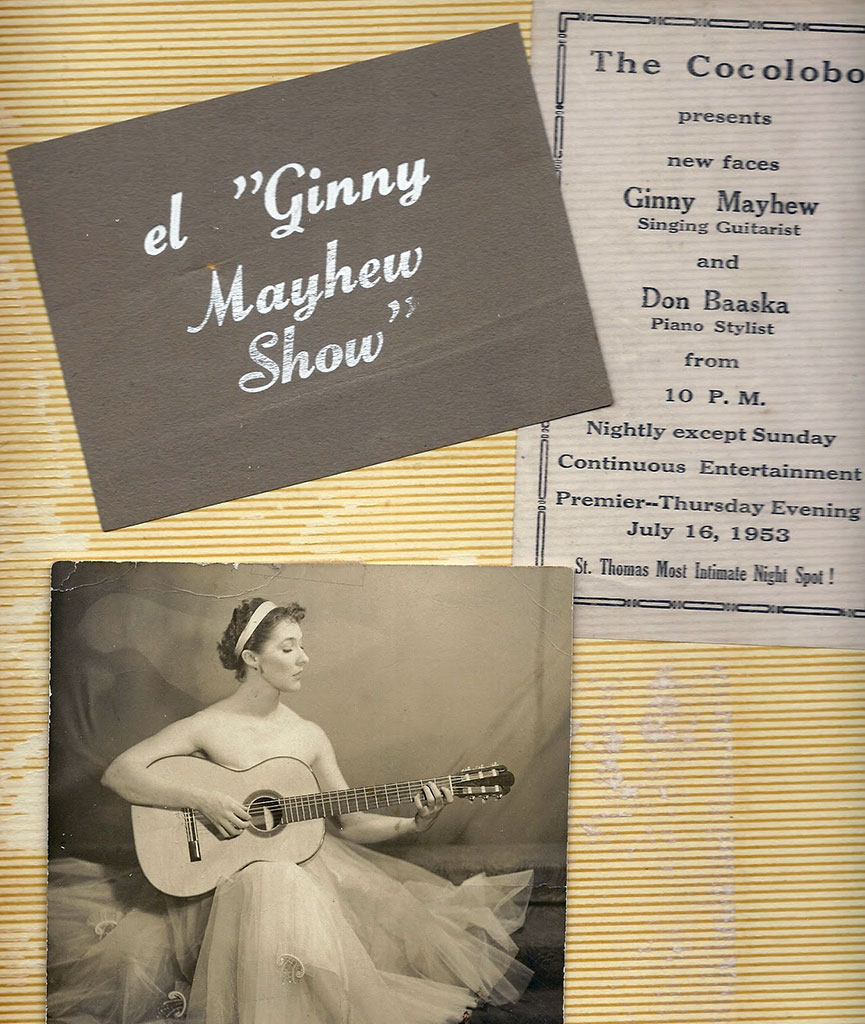 Clippings from 1953 flyers advertising one of Mayhew’s performance on the U.S Virgin Islands
Clippings from 1953 flyers advertising one of Mayhew’s performance on the U.S Virgin Islands
Budo Beginnings
Back in New York, Virginia discovered Japanese budo through judo, which she studied for five years under George Yoshida of the “New York Dojo”. There she met Eddie Hagihara, a fellow 2nd dan judo student and the two eventually got married.
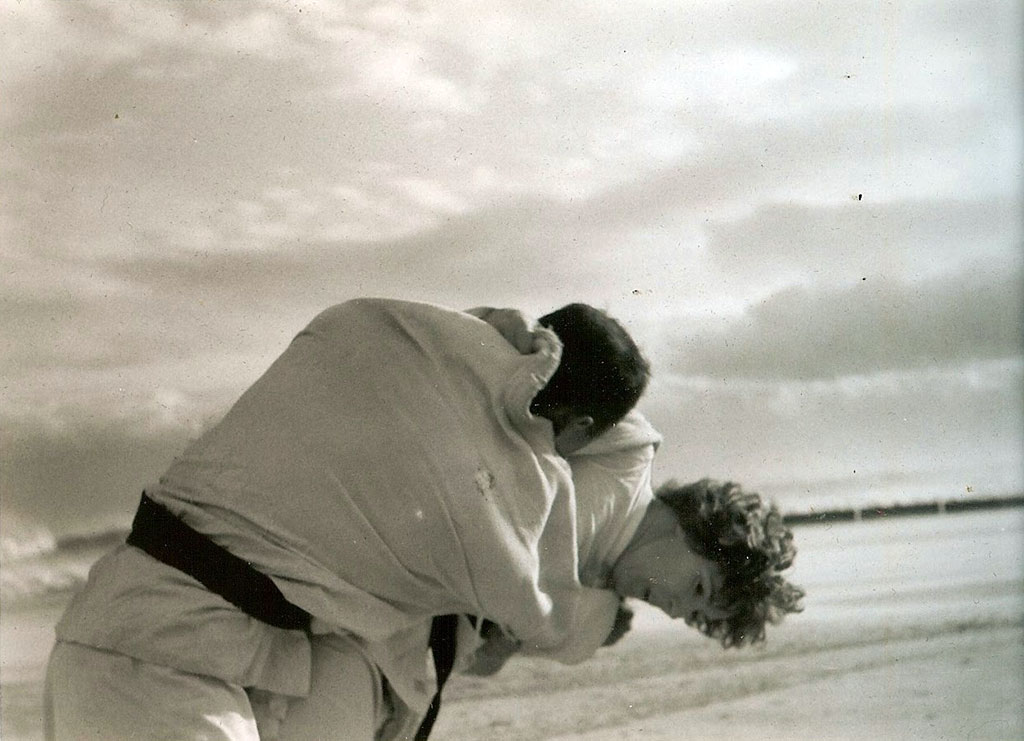 Virginia Mayhew and Fuji Kenichi (3rd dan) - Rockaway Beach, September 12, 1960
Virginia Mayhew and Fuji Kenichi (3rd dan) - Rockaway Beach, September 12, 1960
Virginia got her shodan after about five years of practice, but she became increasingly dissatisfied with judo practice due to the fact that it focused too much on sporting aspects, rather than on spiritual principles. Spiritual development would indeed be a continuous search throughout her life and when she heard that aikido was a martial art that focused on love, compassion, and cooperation, she decided to find out more about it. She and Hagihara began studying aikido in 1962 with Ohara Yasuo (小原 裕雄). Ohara, who was a nidan, had been teaching informally at New York University since 1961.
Foundation of the New York Aikikai
Eddie Hagihara, Virginia Mayhew, Barry Bernstein, Fred Krase, Ralph Glanstein, and a few others helped Ohara set up the New York Aikikai in 1962 at 25 West 19th Street. Practice picked up and students started to join. Advanced practitioners also visited the dojo.
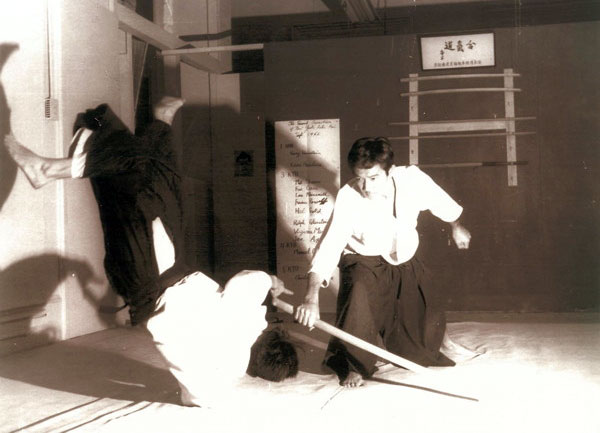 Hawaii’s Meyer Goo throwing Eddie Hagihara at the New York Aikikai. On the back is the list of promotions of the New York Aikikai dated September 1962. Barry Bernstein and Eddie Hagihara are listed as shodan and Virginia Mayhew, Ralph Glanstein, and Fred Crase (sic) as sankyu. [photo courtesy of Aikido Sangenkai]
Hawaii’s Meyer Goo throwing Eddie Hagihara at the New York Aikikai. On the back is the list of promotions of the New York Aikikai dated September 1962. Barry Bernstein and Eddie Hagihara are listed as shodan and Virginia Mayhew, Ralph Glanstein, and Fred Crase (sic) as sankyu. [photo courtesy of Aikido Sangenkai]
Now a shodan, and wanting to learn more about the founder of the art, Virginia travelled to Japan for the first time during the Spring of 1963. She spent about a year training at the old Aikikai Honbu Dojo and she had the opportunity to meet and take ukemi from Ueshiba Morihei. Like so many others before her, she was literally mesmerized by the old master.
O Sensei was having fun. He was natural. Whatever he wanted to say that day, he said it. He could just as easily chuckle or smile as he grunt or scream, but he got pleasure from every moment. Virginia Mayhew
O Sensei allegedly told her that because she was a woman, she would understand that true strength and power comes from within. Being a fiercely independent woman, she seems to have connected with the rather informal ways of O Sensei, compared to other Japanese men.
I never saw a difference between the way O Sensei treated women and the way he treated men. Virginia Mayhew - Remembering O-Sensei: Living and Training with Morihei Ueshiba, Founder of Aikido. Shambhala (November 12, 2002)
Mayhew later reported that she was well used to falling thanks to her judo experience and that therefore, she always knew how and why she ended up on the mat, but when O Sensei threw her for the first time, she was unable to understand exactly how it happened. She reckoned that O Sensei seemed to have a strength of spirit that went beyond his physical movements.
One day, O Sensei immobilized me without direct physical contact with me [...] The strength was hidden behind the physical. Virginia Mayhew - Remembering O-Sensei: Living and Training with Morihei Ueshiba, Founder of Aikido. Shambhala (November 12, 2002)
A report of her stay in Tokyo was published in the Aikido Shinbun (合気道新聞) issue of June 10, 1963. I have added an English translation below for your convenience.
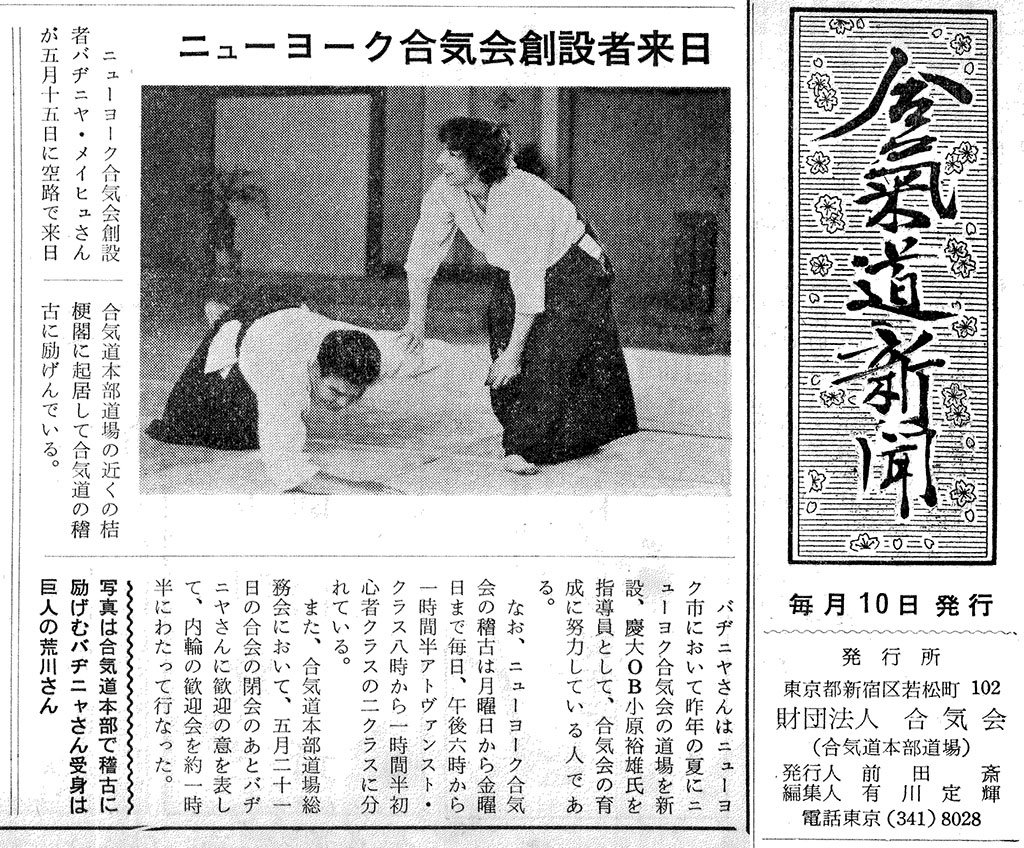 Aikido Shinbun, June 10, 1963
Aikido Shinbun, June 10, 1963
The Founder of the New York Aikikai
Virginia Mayhew arrived in Japan by air on May 15th. She stayed in the Kikyokaku near the Aikido Headquarters Dojo and practiced Aikido with enthusiasm.
Virginia established the New York Aikikai in New York City last summer, and she is working hard to develop the Aikikai in collaboration with Keio University alumnus, Mr Ohara Yasuo as an instructor.
The New York Aikikai lessons are divided into two classes, a one and a half hour advanced class from 6:00 pm, and one and a half hour beginners class from 8:00 pm, every day from Monday to Friday.
In addition, the Aikido Headquarters Dojo General Affairs Committee organized a welcome party for Virginia after the closing of its meeting on May 21st, which lasted about an hour and a half in the presence of the Hombu Dojo staff.
The photo shows Virginia working hard at the Aikido Headquarters. The uke is Mr. Arakawa.
Like a lot of foreigners at the Honbu Dojo, she was also especially inspired by Tohei Koichi, who had brought aikido to the States and who was one of the rare instructors with a good command of English. Another instructor who could communicate in English was Yamada Yoshimitsu, who later recalled the following :
At that time all aikido outside of Japan was controlled by Tohei Sensei. So when this woman called Virginia Mayhew came to Japan, my family and I took care of her personally and we became friends. Yamada Yoshimitsu - Interview with Yoshimitsu Yamada
The New York Aikikai members gave a demonstration at the United Nations. Being so influenced by Tohei, Virginia intended to do some of his exercises including the unbendable arm. However, recognizing that she was in front of an audience of skeptical New Yorkers, she raised the stakes and applied the unbendable arm exercise to her entire body, and had two large men sit on her.
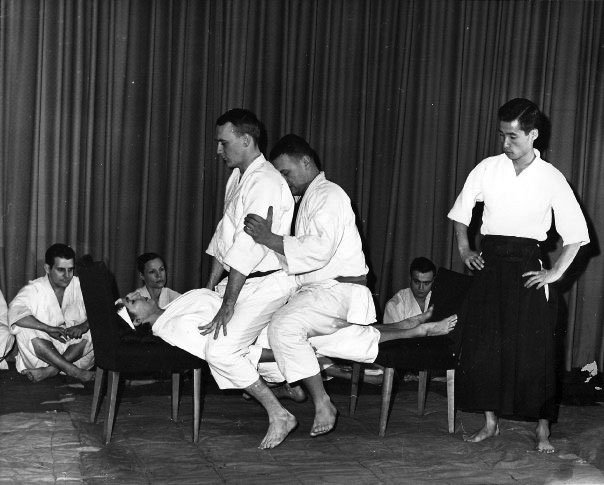 Virginia Mahew demonstrating Tohei Koichi's ki exercises during a demonstration at the United Nations. Ohara Yasuo is standing on the right.
Virginia Mahew demonstrating Tohei Koichi's ki exercises during a demonstration at the United Nations. Ohara Yasuo is standing on the right.
When Ohara moved back to Japan in 1963, Virginia took over the role of the director of New York Aikikai, a position she would hold for over two years, until Yamada Yoshimitsu’s arrival in February 1964.
Though the dojo became increasingly successful, Virginia often took side jobs to pay the rent. She also went through a great deal of effort to generate interest around aikido. Her and fellow students demonstrated aikido on TV on several occasions, including on the Tonight Show with Johnny Carson in 1962. On this particular occasion, she planned to show how aikido could be of value to women so she demonstrated how a woman could apply an aikido technique to control an overly eager male.
She also managed to get aikido talked about in several newspaper articles, and she was instrumental in organizing aikido’s participation at the New York World’s Fair from May 11 to 17, 1964. In order to fully prepare for this later event and coordinate the dispatch to New York of the then 4th dan Yamada Yoshimitsu, she made another short stay in Tokyo in February 1964, which was reported in the April 1964 issue of the English version of the Aikido Newspaper.
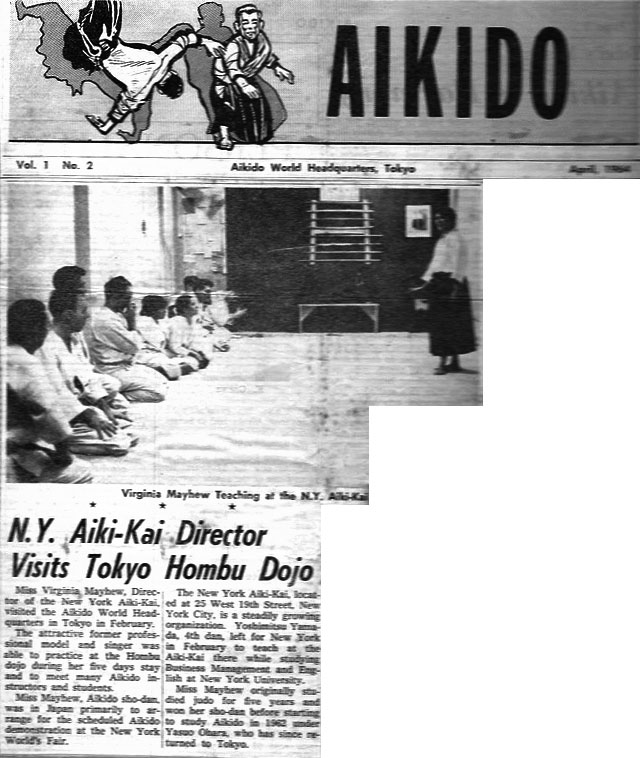 Virginia Mayhew’s article in the Aikido Newspaper Issue #2 from April 1964
Virginia Mayhew’s article in the Aikido Newspaper Issue #2 from April 1964
Virginia and Yamada Yoshimitsu came back in New York in February 1964. Hagihara, who had been in Japan since June 1963 returned to New York at the end of April 1964 and he opened his own dojo, the Long Island Aikikai, that same year, with the help of Virginia, who was instrumental in finding a place and securing the blessing from Tohei Kochi.
Then, in 1964, I came to New York for the World's fair. The plan was for me to go with Tohei Sensei to the Japanese Pavilion and perform a demonstration. But he was unable to go on that trip. So I came by myself.[...] I met my friends in New York and went to the New York Aikikai. I spoke to the members and became Chief Instructor. Yamada Yoshimitsu - Aikido Today Magazine Volume 18, Jan/Feb 2004
The World Fair aikido demonstration took place at the Japanese Pavillion in Flushing Meadows, Queens, New York and a video was shot. Glimpses of Virginia are visible in the bottom right of the frame, as she is providing a commentary over a microphone during the demonstrations.
Demonstration at the World Fair 1964
Return to Japan
Now free from the responsibility of running the dojo, and recently separated from Hagihara, Virginia travelled back to Japan in the aim of studying aikido as a full time Honbu Dojo student. On her way, she stopped in Hawaii for three weeks during the winter of 1964. She got the chance to practice with a number of instructors there, as well as Tohei Koichi.
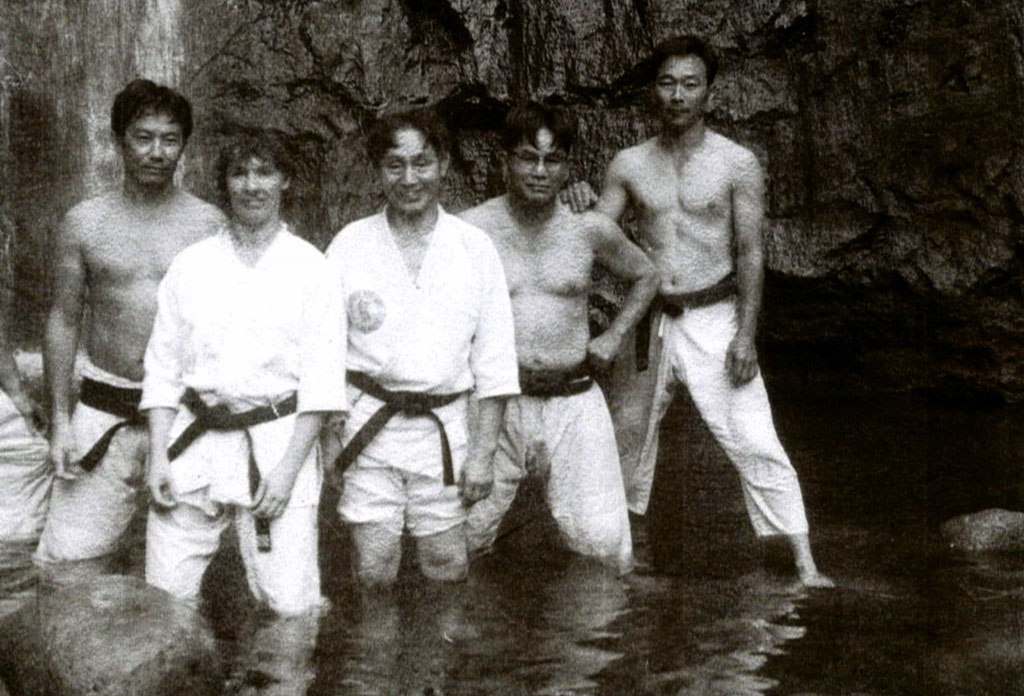 Meyer Goo, Virginia Mayhew, Yukiso Yamamoto, Henry Horii, and Sadao Yoshioka undergoing misogi practice in Hawaii.
Meyer Goo, Virginia Mayhew, Yukiso Yamamoto, Henry Horii, and Sadao Yoshioka undergoing misogi practice in Hawaii.
She later recounted her experience in the English version of the Aikido Newspaper published by the Aikikai.
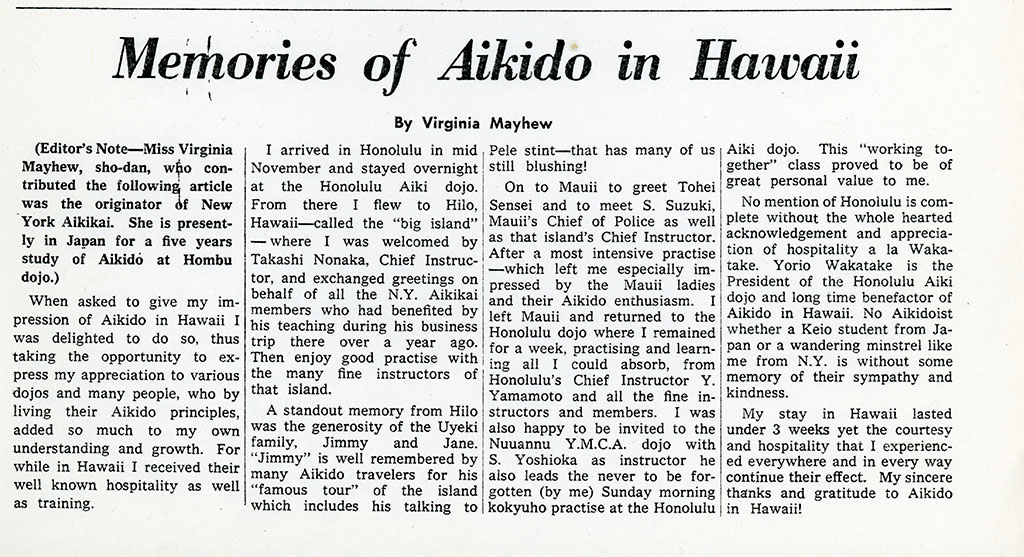 Virginia Mayhew reporting on her stay in Hawaii in the June 1965 issue of the Aikido Shinbun
Virginia Mayhew reporting on her stay in Hawaii in the June 1965 issue of the Aikido Shinbun
When she eventually arrived in Tokyo in December 1964, she became acquainted with Henry Kono, a Japanese-Canadian who had serendipitously ended up at Honbu in October 1964. The two forged a close friendship that would last a lifetime. Being both in their mid to late thirties, they shared a particular interest in the overarching principles that were behind the aikido movements, rather than the physical side, unlike many of the younger students. Still in the pursuit of spiritual growth, Virginia also regularly engaged in zen meditation.
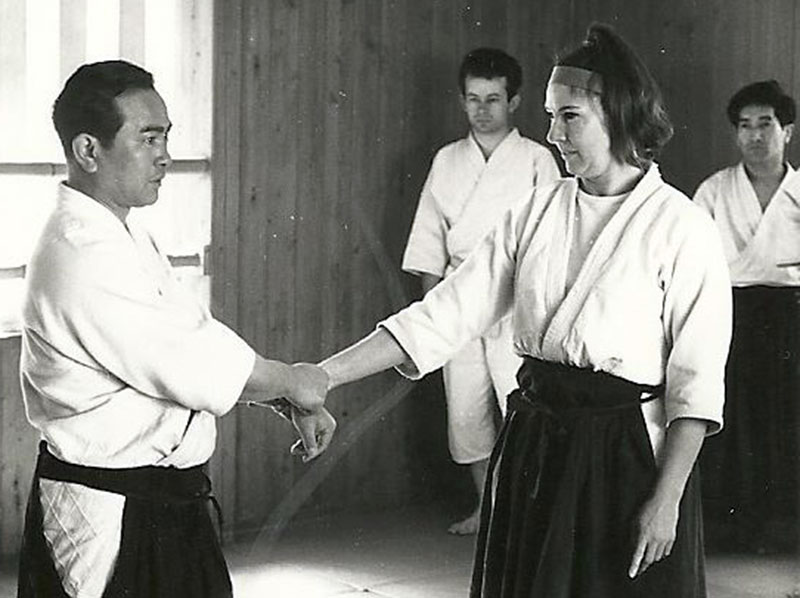 Tohei Koichi teaching Virginia Mayhew. At the back on the right is Henry Kono.
Tohei Koichi teaching Virginia Mayhew. At the back on the right is Henry Kono.
In 1966, the pair reconnected with Alan Ruddock, an Irishman who had come back to Japan after a brief first stay in 1965. His goal was also specifically to learn aikido from the founder. They formed a relatively close group of foreigners along with Kenneth Cottier, Terry Dobson, Joanne Shimamoto, George Willard, and a few others.
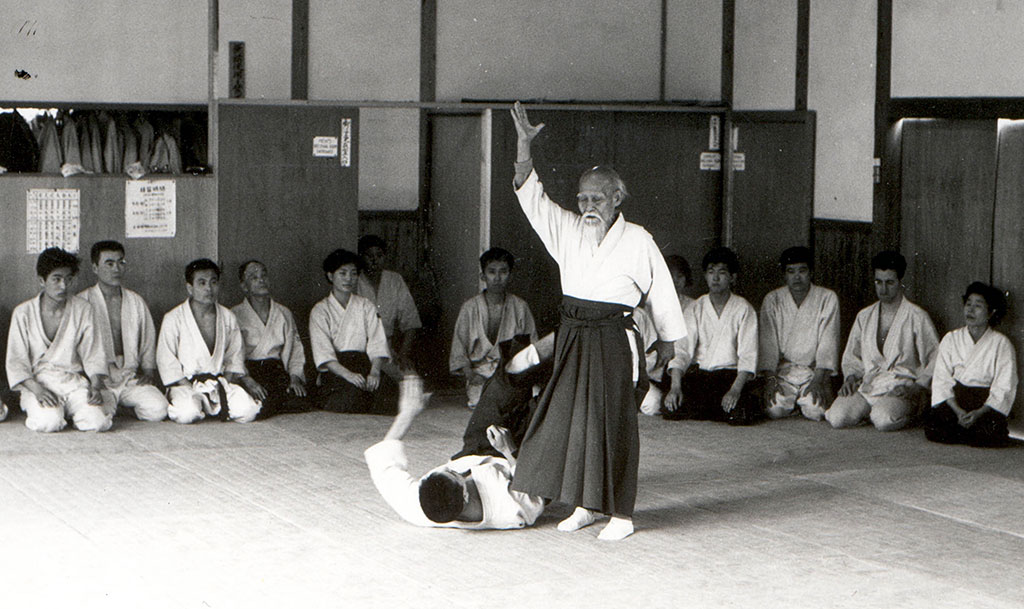 O Sensei teaching at the Hombu Dojo. Ruddock is visible, second from the right.
O Sensei teaching at the Hombu Dojo. Ruddock is visible, second from the right.
While she could not be an official uchi deshi because of the fact that she was a woman, she did have unprecedented access to O Sensei because she helped out in his household by cooking and cleaning for him.
A Note on Grades
I looked into the Aikikai publication archives in order to find the record of the grades awarded to the various people cited herein. I found that both Barry Bernstein and Eddie Hagihara’s names appear as part of the newly promoted to shodan, under the header “New York Aikikai” in the December 10, 1962 issue of the Aikido Shinbun. In the same issue, other New York Aikikai members are listed such as Goe Anelrod (3 kyu), Manvel Gilyard (4 kyu), and Christopher Oliana (5 kyu). Both Bernstein and Hagihara’s names are found again in the August 10, 1965 issue where they are part of the newly promoted nidan, while Fred Crase is listed as shodan.
Unfortunately, I was unable to find any record of Virginia Mayhew’s shodan. A small number of issues are missing from the record and it is possible that her name might have been there. I did manage to locate her name in the issue from September 10, 1966, where she is listed as a nidan from the Hombu Dojo. On the same issue, George Willard is listed as shodan.
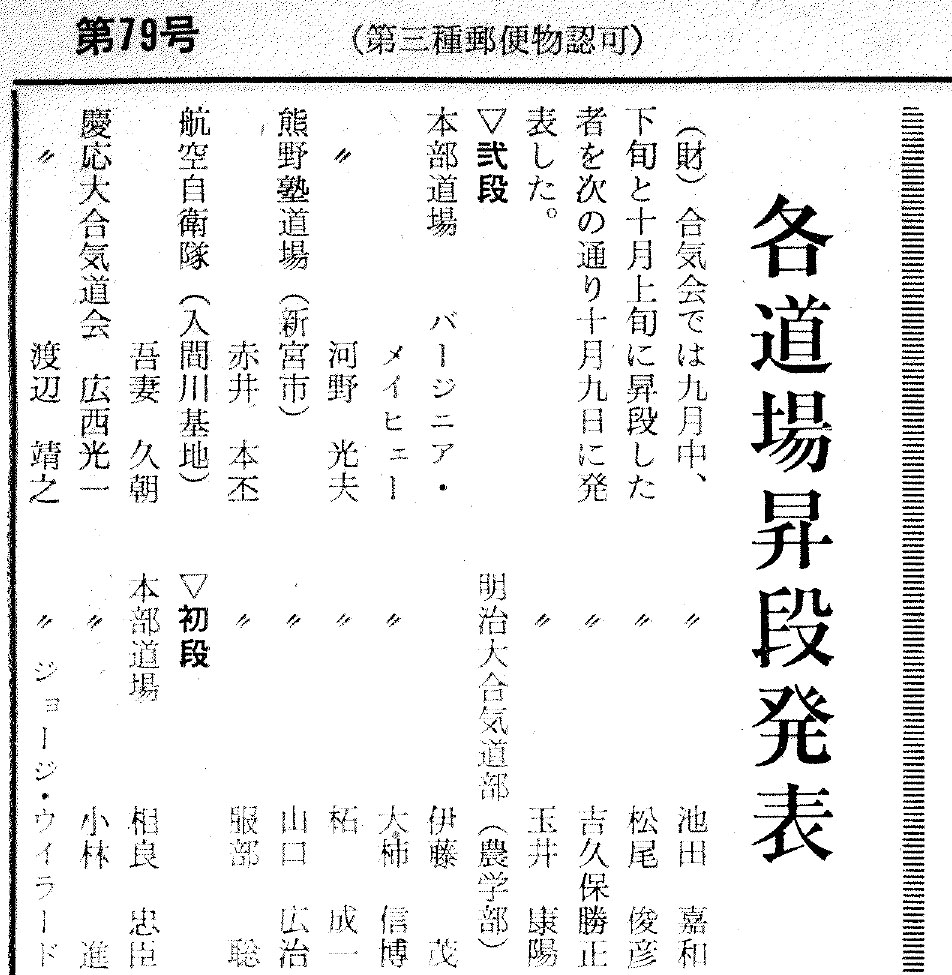 Aikikai Shinbun issue from September 10, 1966. Virginia Mayhew (バージニア・メイヒュー) is listed as nidan from the Hombu Dojo.
Aikikai Shinbun issue from September 10, 1966. Virginia Mayhew (バージニア・メイヒュー) is listed as nidan from the Hombu Dojo.
The picture of her actual nidan certificate was later sent to me by her daughter, Dr Shankari Patel. It is dated from October 3rd, 1966, and bears the seal of Ueshiba Morihei.
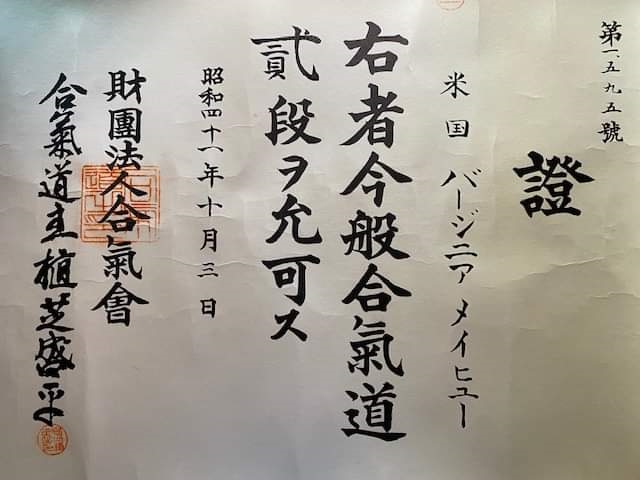 Viginia Mayhew's nidan certificate dated from October 3rd, 1966 and bearing the seal of O Sensei.
Viginia Mayhew's nidan certificate dated from October 3rd, 1966 and bearing the seal of O Sensei.
For additional context, I kept looking in the archives and found that Terry Dobson was listed as shodan in March 1963, Henry Kono in July 1965, Ken Cottier in December 1965, and Alan Ruddock in October 1967. In terms of seniority, Virginia would therefore have been on par with Terry Dobson.
Virginia was a good friend; she used to give me guitar lessons. Kenneth Cottier - Frank! Aikido Chats. p.44
Another entry that caught my eye was the record of the 1966 shochu geiko, the summer training, which took place from Monday, July 25th to Wednesday, August 3rd. The entry lists the names of the 113 people people who had perfect attendance during those ten consecutive days at the peak of the summer heat. The tradition still goes on today.
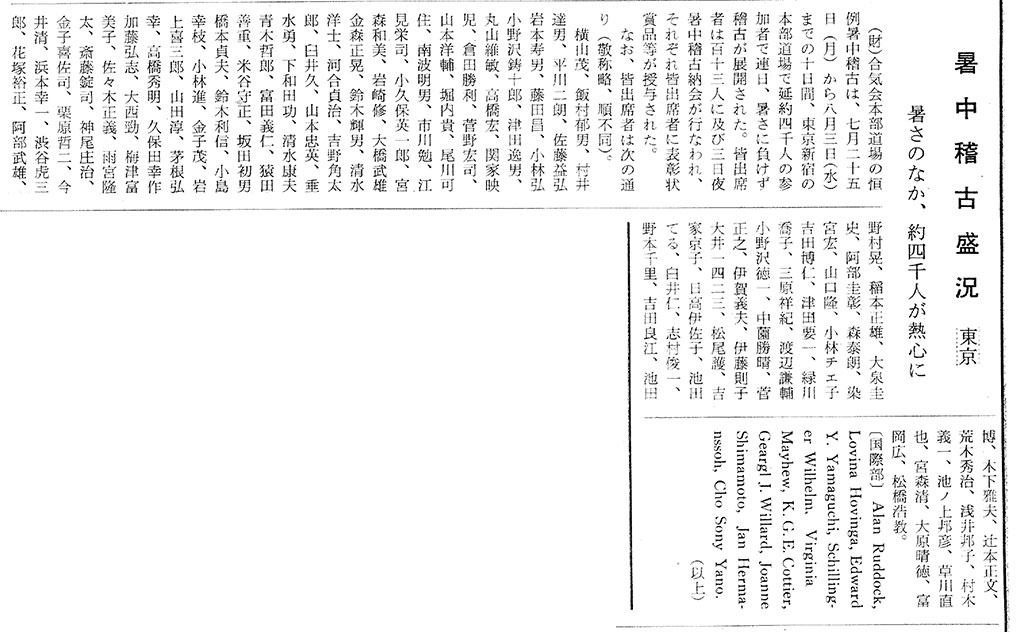 Issue from August 1966 showing the list of students who had perfect attendance during the shochu geiko.
Issue from August 1966 showing the list of students who had perfect attendance during the shochu geiko.
Kickstarting Aikido in Hong Kong
While in Tokyo, Virginia met a Hong Kong woman and the two got along so well that she latter invited Virginia to Hong Kong to become her personal aikido teacher. Instead of staying five years in Japan as she had initially planned, Virginia therefore only stayed two before moving to Hong Kong in 1966 at the request of her friend.
She received permission from O Sensei to start a dojo and before leaving, he presented her with a handwritten scroll so that she could display it in her dojo. She arrived in Hong Kong on a Tuesday. Wasting no time, she put up a demonstration the following Friday at the YMCA in Kowloon and began teaching classes the Monday after.
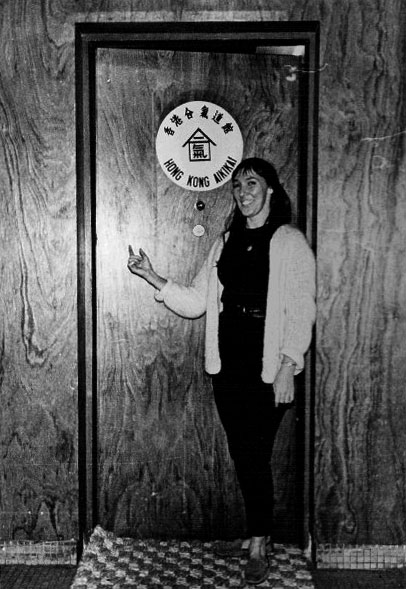 Virginia Mayhew posing in front of the Hong Kong Aikikai
Virginia Mayhew posing in front of the Hong Kong Aikikai
The following year she secured a more permanent location in Tsim Sha Tsui, Kowloon and established the Hong Kong Aikikai. She also taught in a number of other venues, including another YMCAs, the Hong Kong Airport, a dancehall, and local schools including St. Francis School for Boys. She had close to 300 students in total at the height of her stay in Hong Kong.
[Seigo Yamaguchi Sensei] had brought aikido to Burma and he thought highly of Virginia Mayhew teaching aikido in Hong Kong. Alan Ruddock - Interview with Alan Ruddock
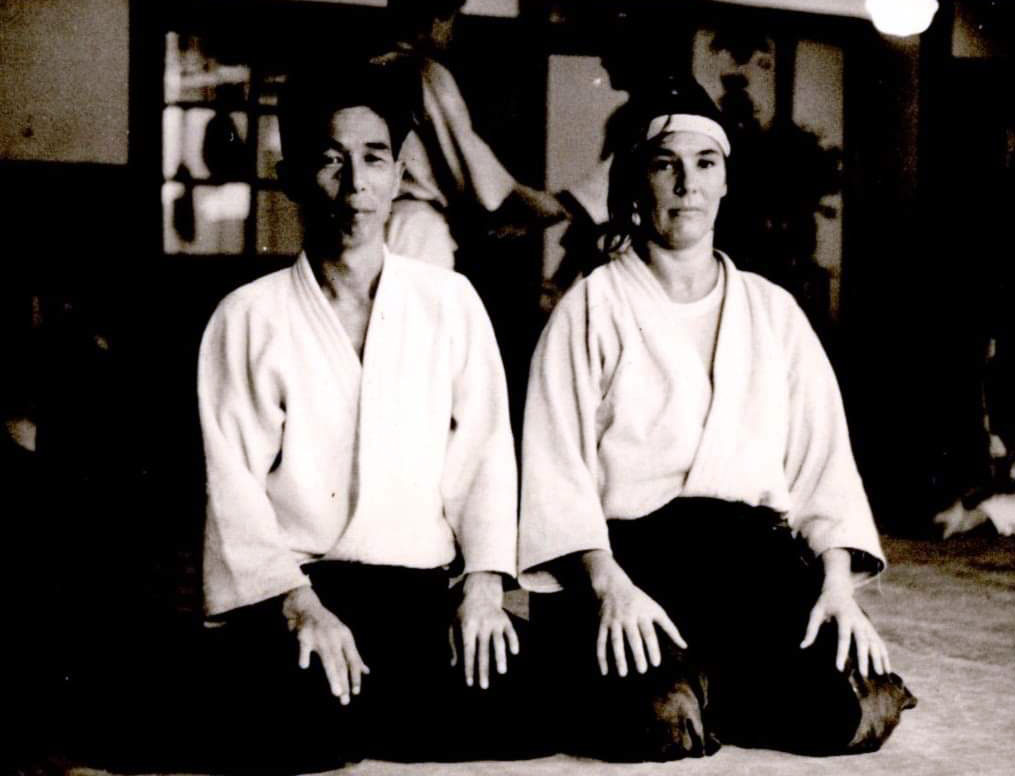 Yamaguchi Seigo and Virginia Mayhew
Yamaguchi Seigo and Virginia Mayhew
Given this success, she realized that she needed support with the teaching, and both Kono and Ruddock came to help her on several occasions. Alan Ruddock actually spent several months teaching in Hong Kong at the end of his stay in Japan, prior to returning to Ireland.
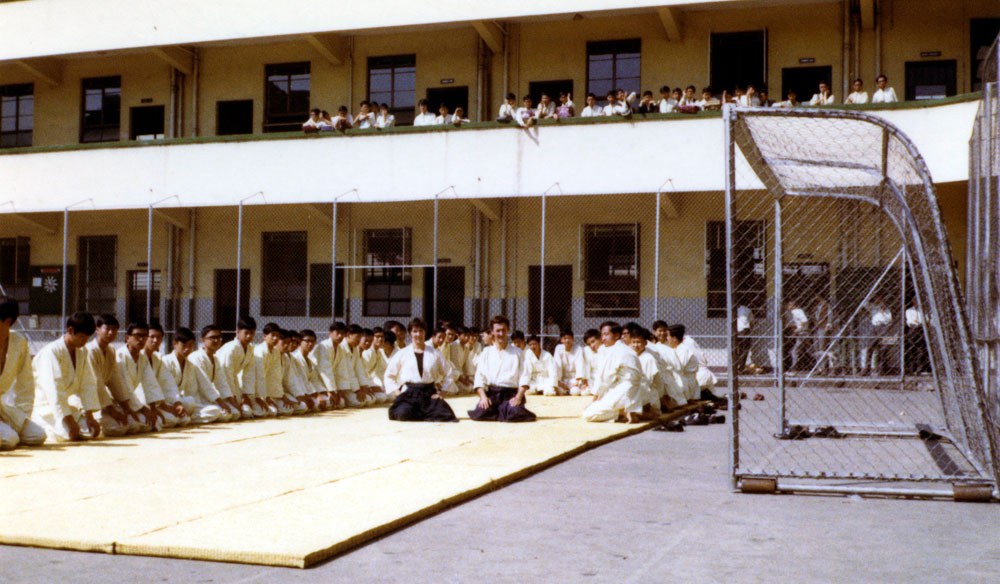 Alan Ruddock and Virginia Mayhew in Hong Kong
Alan Ruddock and Virginia Mayhew in Hong Kong
According to one of her students at the time, Virginia also used the skills that she had acquired on the tatami in real life. She allegedly assisted a Royal Hong Kong Emergency Unit cop escape from a mob of rioters in the Sham Shui Po district, Kowloon. The man is said to have become her student afterwards.Harvey, David - Woman Saved Cop From Riot Mob.
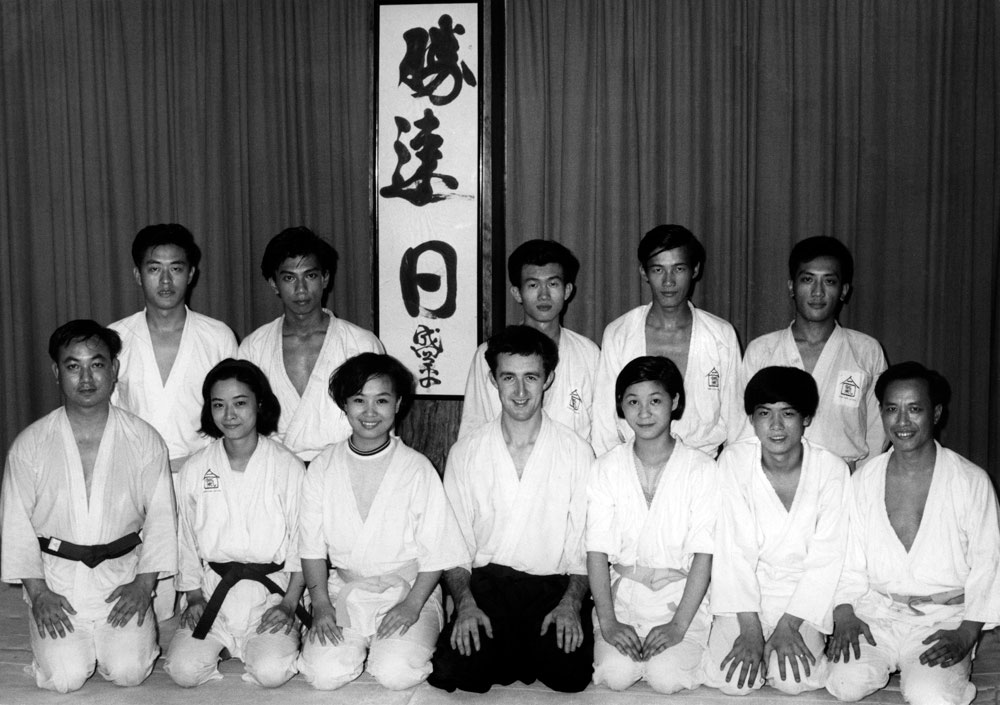 Alan Ruddock posing in front of O Sensei’s calligraphy with the students of the Hong Kong Aikikai. The character are 勝速日, meaning “Victory Day”. This is part of one of the founder’s favorite expressions from the Kojiki: Masakatsu Agatsu Katsuhayabi (正勝吾勝勝速日).
Alan Ruddock posing in front of O Sensei’s calligraphy with the students of the Hong Kong Aikikai. The character are 勝速日, meaning “Victory Day”. This is part of one of the founder’s favorite expressions from the Kojiki: Masakatsu Agatsu Katsuhayabi (正勝吾勝勝速日).
After Ueshiba Morihei’s passing on April 26, 1969, Virginia decided that it was time to move on and she returned briefly to Tokyo in the aim of arranging her replacement. This proved unsuccessful and the school ended up without an instructor for about two years, until Ken Cottier was sent by the Aikikai to restart the organization. He founded the Hong Kong Aikido Association, which is still running today.
I did go to Hong Kong and established the Hong Kong Association. [...] These people [had] trained with Virginia Mayhew so as soon as I got there, I graded them to 2nd kyu, I thought they were well worth 2nd kyu, they had had quite a bit of exposure. Kenneth Cottier - Frank! Aikido Chats. p.44
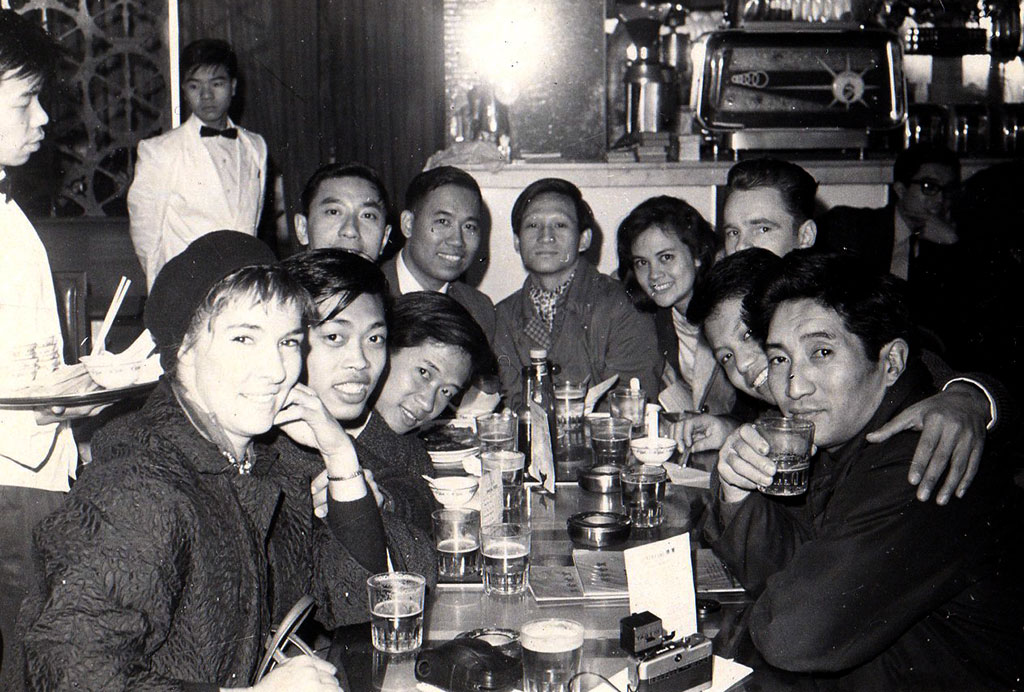 Virginia Mayhew, Henry Kono, and their students grabbing a bite to eat after aikido class.
Virginia Mayhew, Henry Kono, and their students grabbing a bite to eat after aikido class.
Return to the United States
Virginia returned to the United States. She would continue her pursuit of awareness and centering through meditation, which led her to India, where she learned from a guru for some time. There she married an Indian businessman and took on the family name of Patel. The couple had a daughter named Shankari, who has been very active in writing about her mother and who is the source for much of the information in this article.
When I was seven my mom and I moved to southern California and lived in an old motel in downtown Los Angeles. Late one night, when we were returning to our room an angry man wielding a bat blocked our path and demanded our money. My mom tried to reason with him and offered to share her money. That just seemed to make him angrier and he came at my mom swinging his bat menacingly above him. I remember being frightened the minute my mom moved towards him. I didn't understand irimi then so it didn't make sense to me why she would move towards a man who was about to hit her with a bat. The actual confrontation lasted only a matter of seconds. The bat never connected with my mom because all of a sudden it was in her hands and then she had the guy's wrist in a painful wrist lock. She leaned down close to him and said, "I am not going to hurt you but you should know that it is unwise to attack a woman especially when her child is present. When I let you go you'll leave peacefully but we will be keeping your bat." When she finally did let go of his wrist her would-be attacker couldn't flee fast enough. Patel, Shankari - Irimi
She went back to Hawaii, where her daughter was born, and trained in aikido but did not teach. While she continued to practice on her own or with like minded friends after she returned to the US, she no longer held any formal aikido position after that.
In 1993 Henry Kono traveled to Los Angeles with his young son and met up with Virginia. They reportedly talked for hours about Aikido and O Sensei and what spiritual insights they had gained into his teachings over the years. Virginia Mayhew later suffered a stroke. She passed away on October 26th, 2006 at age 77.
Many thanks to Dr Shankari Patel, the daughter of Virginia Mayhew, for her help with providing the information and documents for the writing of this article.
Sources:
- Aikikai Archives: 合気道新聞, Aikido Newspaper
- Appelbaum, Neil - The New York Aikikai. Black Belt Magazine (May 1965)
- Bennett, Peter - An Aikido Oddity: Englishman Teaches Japanese Art to Chinese. Black Belt Magazine (March 1972)
- Bush, Chuck - Training With O Sensei. Black Belt Magazine (April 1988)
- Patel, Shankari - Feminist Aikidoka
- Ruddock, Alan - Aikido Memoirs: One Irishman's Lifetime Search for the Answer to the Mystery of Morihei Ueshiba's Aikido. Aiki Pathways; 2nd edition (August 1, 2011)

